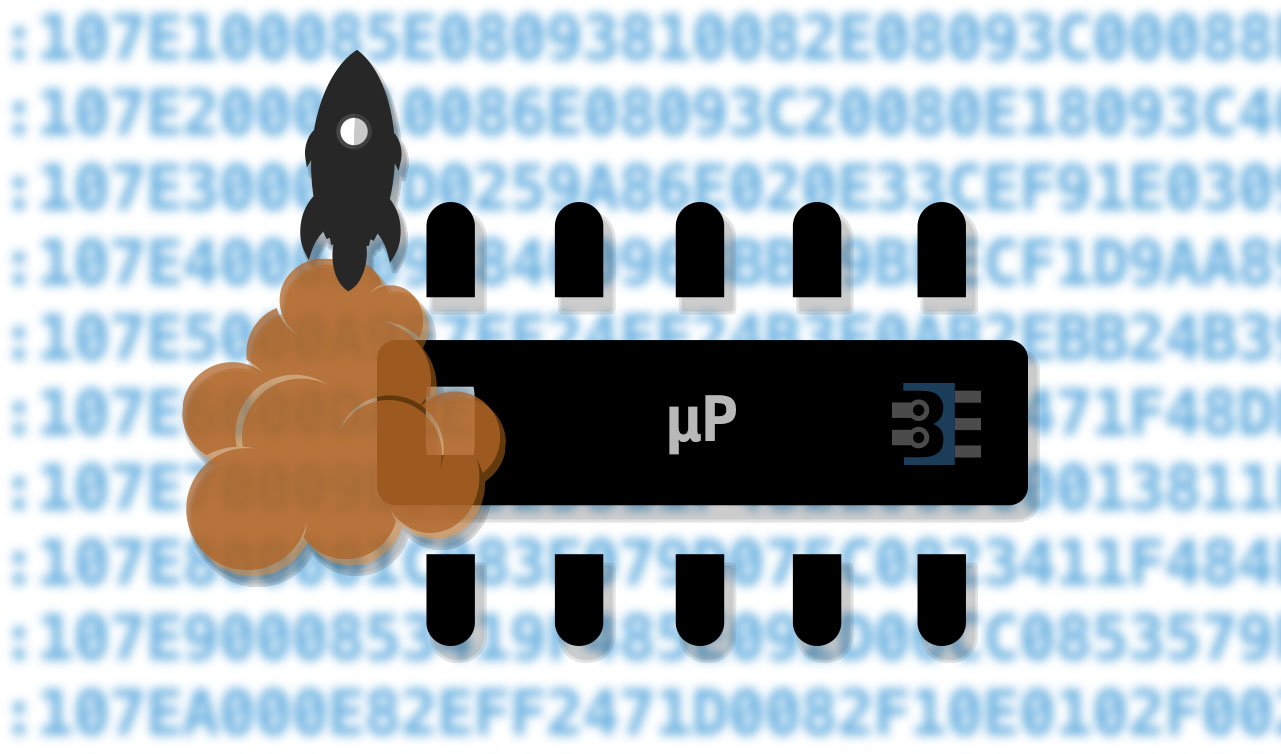Almost all microcontroller (and microprocessor) development systems use some form of a bootloader. Often called firmware, mistakenly, the Arduino bootloader is one example. Since it is a rather popular platform, let’s use it as an example. Let’s talk about what a bootloader does and how it works.
When a microcontroller turns on, it only knows how to do one thing. Typically, that one thing is to run an instruction found at a specific memory location. Often this location address 0x0000, but not always. Usually, this memory location will contain a jump instruction to another place in memory, which is the start of the user program. The bootloader, however, exists in a slightly separate memory space from the user program.
On power-up or reset, a bootloader is a section of program memory that runs before the main code runs. It can be used to setup the microcontroller or provide limited ability to update the main program’s code.
How the Arduino Bootloader works
The Arduino bootloader supports re-programming the program memory (or Flash) over serial. Without it, you would need a dedicated hardware programmer, like the USBtiny, to change the code in the Uno’s ATmega328p.
Like many microcontrollers, the ATmega328p dedicates a portion of its program memory for bootloading code. In the case of the Uno, the Arduino bootloader waits a short time while watching the UART pins. If the bootloader does not receive a particular sequence of bytes over the serial port, then the processor jumps to the “user” program section to load whatever is already in program memory. This jump loads your program (or sketch).
If the pre-defined sequence is received, the Arduino bootloader pretends to be an AVR programmer. In the case of the Uno, a unique programming protocol called “arduino” is used. This “special protocol” is a variant of the stk500 hardware programmer. Other Arduino boards have other programmer types they emulate.
At this point avrdude will begin sending your program’s binary data with a protocol over the virtual serial port. The program memory (PROGMEM) of the ATmega328p stores the incoming byte stream. Once completed, the chip resets and starts the new code.
Re-programming the FLASH, without a dedicated programmer, is only possible when the code is running during the “bootload” phase. The idea is to prevent malicious (or buggy) code from changing the contents of Flash.
In short:
- The Arduino bootloader is always the first stuff to run.
- If the bootloader receives a unique sequence, then the byte stream is programmed into FLASH
- Else, the bootloader turns control over to the existing user code.
Leonardo Bootloader Note
On the AVR 32u4 based Leonardo and Micro boards, the bootloader works differently than the serial-based Arduino. For a detailed explanation of the boot sequence, read this Leonardo product page. They still use a bootloader, but it works different from the 328p and Mega2560 variants.
Bootloader Advantages
At a higher level, bootloaders can be used to either pre-configure a microcontroller/microprocessor or, in the case of the Arduino bootloader, allow “field programming” of an end device. While you might use the Arduino bootloader to test and develop code in your project, you could also use the bootloader to update code in a shipping product.
While bootloaders offer incredible advantages, there are some aspects you should consider if you keep a bootloader installed on a finished project.
Bootloader Tradeoffs
Looking back at how the Arduino bootloader works, remember that it delays executing the “real” program code. That fact means there is a delay before for your code runs at start-up.
If you have bootloader code, that is less memory space for your program. The Uno’s optiboot bootloader takes up 508 bytes (512-byte block minus the remaining 4 bytes). Keep in mind that with 32k of Flash memory, regaining an extra 512 bytes might not mean much.
Since the Arduino bootloader runs before your code, it might set some of the registers differently than expected. For example, some people had trouble with the watchdog timer on early versions of the Arduino bootloader. Fortunately, the optiboot bootloader, which is more common today, solves the watchdog timer issue.
More information
- Bootloader Page on Arduino.cc
- Bootloader Tip, Tricks, and Techniques from Adafruit
- USB Tiny, dedicated programmer, from Adafruit
- Optiboot Source on Github
- Detailed Optiboot information from Arduino Forum
Conclusion
The Arduino bootloader makes programming a board like the Uno a piece of cake. Bootloaders are not perfect and take some resources you might need for your project. However, the trade-offs are usually worth it!






10 Comments
Can I add an application program in the bootloader i.e. navigational menu on TFT display? The menu will have an option to run predefined user programs and also has a menu option to receive a new user program uploaded from Arduino sketch.
According to the datasheet, the ATmega328p’s bootloader section can be up to 2048 bytes. So if you can write all your code to work within 2K of flash memory, then yes you can.
Sir
I am new to microcontroller stuff.
I am a programmer ofcourse and using vb.net c# and sqls at back ends.
I am studying microcontrollers especially arduino and avr for the last one month of which some help and some did not.
I want to ask you the Following:
1. When we load a sketch as Arduino as ISP, does the target chip autmatically boot loaded?
2. If I boot load say ATTiny84 with Arduino Nano and want to load a program with AVR Studio, what is the Scenario?
Would you please clear this points.
Thanks in advance Sir.
I am a beginner. I have an UNO board with ATMEGA 328. How do I know that there is boot loader already? if not how do I install?
thanks for the very clear explanation. In case I want to programme an Arduino with a programmer via ISP, should I first remove the bootloader? Thanks, Folkert
Uploading a new program via ISP will overwrite the bootloader.
Sir
I have developed a program using uni
And I want burn that program into fresh chip
Atmega328p without bootloader
Explain
Because I want make stand alone application
Use a hardware programmer.
Nice work from you, keep it up,
I have worked on arduino but some things are still confusing for me.
1- Is arduino suitable for development of drones, commercial products, for high tech research like drones, computer vision, image processing applications etc.
2- As i think it just covers some AVR controllers so we are bound with some chips, specific IDE and specific coding style, which makes it impractical for real time application and wide range of controllers.
3- Coding style is not user friendly , have to write most of part a long coding in a one loop.
4- Arduino still not explored all I/O of some controllers, like atmega 2560 not all interrupts and i/o are useful.
So how should can consider it most perfect tool for development?
These are all very different things. The Arduino as a platform is a prototype tool. You wouldn’t include it as-is into a commercial product. You would, however, use it for development.
As for drones, there are many Arduino-based drone controllers on the market. That’s the strength of a Microcontroller.
For image processing and vision, that is better suited for an ARM-based microprocessor.
I don’t know what this comment means. No development environment is practical for a wide range of controllers.
However Ardunio IDE has been adapted to Energia for TI MSP platform and there was wiring before it. That’s a pretty wide range.
I don’t agree. Almost all embedded development follows this structure. I see no issue with it.
Again, I don’t understand your question. No tool is perfect. The Arduino makes it easy to use many of the peripherals in the AVR chips. If there is support missing for something you want, and no one has created a library, then perhaps you need the professional development tools from Atmel.